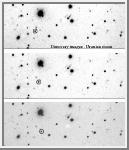















|
The discovery of two probable distant satellites of Uranus was reported by B. Gladman, P. Nicholson, J. Burns and J. Kavelaars. The satellites were observed using the Hale 5-meter telescope at Palomar Observatory with a COSMIC camera CCD imager. Observations were made on September 6 and 7 as well as in early October. This discovery was reported in the IAU Circular 6764. The brighter object is designated as S/1997 U 2 and the fainter object as S/1997 U 1.
The preliminary calculation of the orbits was reported in the IAU Circular 6765.html which reports that the best-fitting orbit for S/1997 U 2 is a very eccentric uranicentric orbit with a retrograde solution being significantly preferable to a direct solution. Because S/1997 U 1 is fainter and harder to observe, the solution to its orbit is less conclusive. The preliminary estimates of the radius of S/1997 U 1 and S/1997 U 2 are 40 kilometers and 80 kilometers.
| Animations of the New Moons of Uranus |
|---|
| Views of the New Moons of Uranus |
|---|
 Discovery image of S/1997 U 2
Discovery image of S/1997 U 2
This shows the discovery image of brighter of the two new moons of Uranus.
It is designated as S/1997 U 2 until the International Asronomical Union (IAU)
comes up with a name for the satellite. Notice the motion of the moon (circled)
with respect to the background stars. The images were taken roughly one hour
apart on September 7, 1997. A faint asteroid in the main belt (not circled) may
also be observed and identified by its much faster rate of motion.
(Credit Brett Gladman, Canadian Institute for Theoretical Astrophysics and
Cornell University)
 Discovery image of S/1997 U 1
Discovery image of S/1997 U 1
This shows the discovery image of faint new moons of Uranus.
It is designated as S/1997 U 1 until the International Asronomical Union (IAU)
comes up with a name for the satellite. The glare from Uranus, which was placed
intentionally off the frame to avoid saturating the detector, is visible at the
right.
(Credit Brett Gladman, Canadian Institute for Theoretical Astrophysics and
Cornell University)
 Nicer Color Image of S/1997 U 1
Nicer Color Image of S/1997 U 1
This shows another discovery image of faint new moons of Uranus.
It is designated as S/1997 U 1 until the International Asronomical Union (IAU)
comes up with a name for the satellite. The glare from Uranus, which was placed
intentionally off the frame to avoid saturating the detector, is visible at the
right. The moon must be located by looking at the above image.
(Credit Brett Gladman, Canadian Institute for Theoretical Astrophysics and
Cornell University)
 Positions of the Moons Relative to Uranus
Positions of the Moons Relative to Uranus
This diagram shows the position of the moons relative to Uranus.
Uranus is shown at the center of the plot (not to scale). The circular orbits
of the outermost two previously known moons (Titania and Oberon) surround the
planet, and appear as ellipses because the orbits viewed from Earth are somewhat
edge on. The four search fields for the discovery observations of September 6
and 7 surround the planet, each box (dashed) showing one field that the digital
detector saw during a single exposure. The fainter moon was discovered almost
directly east of the planet (note that east is to the left when looking up at the sky
while facing south). The brighter moon was west and somewhat north at the time of
discovery. The arcs that the satellites followed after discovery are shown,
corresponding to the preliminary fits to the orbits of the moons, calculated
by Brian Marsden of the Minor Planet Center at Harvard University. The
observations from the Palomar 5-meter telescope are shown as large dots. The
small squares on October 9 and 18 are two of several observations beginning on
the former date by the amateur astronomer Warren Offut. The predicted paths are
shown out until November 15th, 1997. Observations after this date will be
difficult due to the fact that the Earth is moving to the opposite side of
the Sun than Uranus, and so the planet will become unobservable until the spring of 1998.
(Credit Brett Gladman, Canadian Institute for Theoretical Astrophysics and
Cornell University)